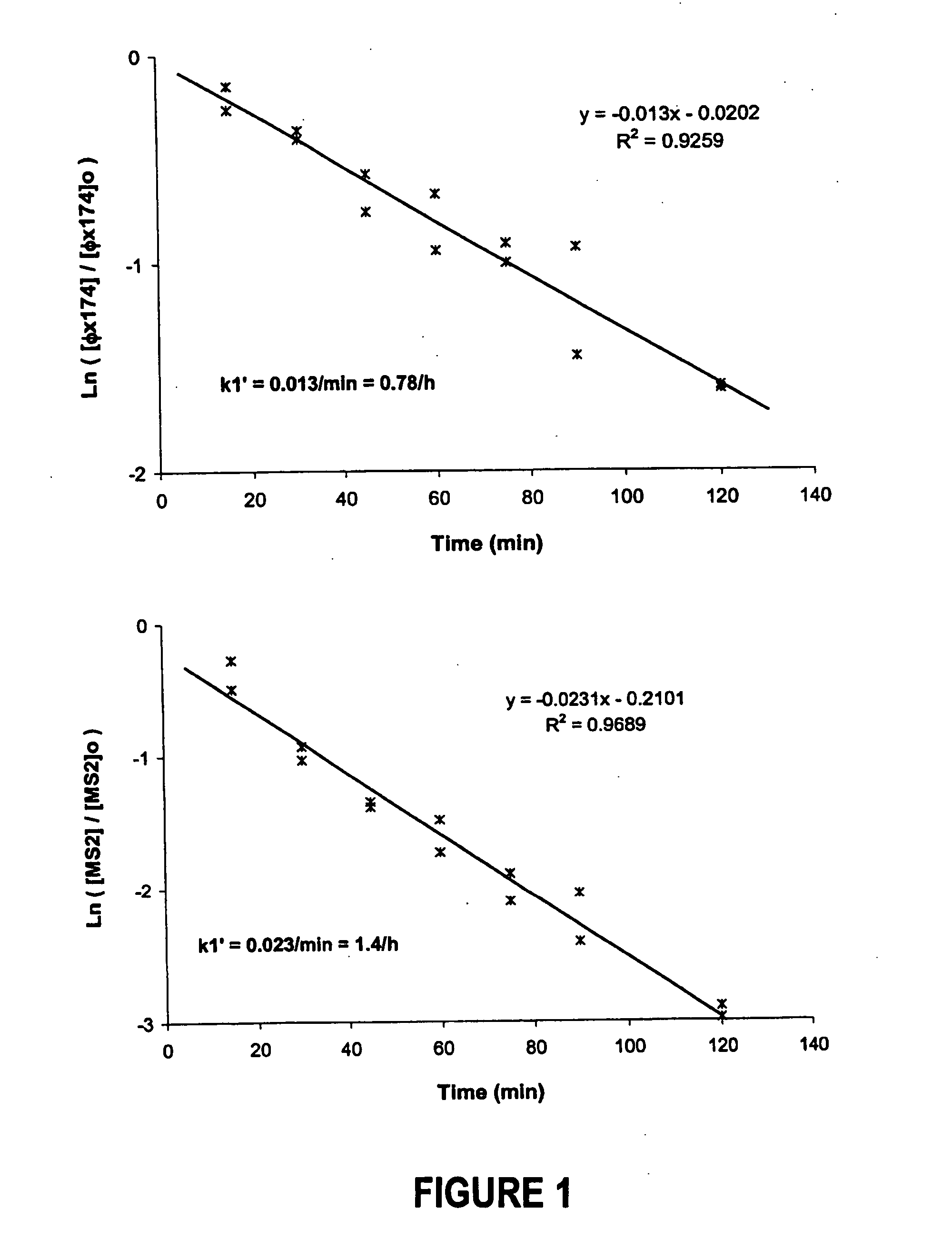Removal of microorganisms and disinfection byproduct precursors using elemental iron or aluminum
a technology of disinfection byproducts and elemental iron or aluminum, which is applied in the field of media treatment processes, can solve the problems of difficult control of cryptosporidiosis, death in the more sensitive subpopulation, and classical disinfectants such as chlorine have been shown to not always be sufficiently effective against viruses and protozoa
- Summary
- Abstract
- Description
- Claims
- Application Information
AI Technical Summary
Benefits of technology
Problems solved by technology
Method used
Image
Examples
example 1
[0062] Batch Experiments. Batch experiments were conducted to study the kinetics of virus removal by Peerless™ iron particles. Stock solutions of φX174 and MS-2 were diluted in AGW to the desired titer (˜ / 105 pfu / mL). Experiments were performed using 250-mL amber borosilicate bottles prepared in duplicates. Following addition of 1.0 g iron particles, the bottles were filled completely (free of headspace) with virus solution and sealed immediately with an open-hole screw cap and a Teflon-lined silicone septum (10 / 90 mil, Alltech, Deerfield, Ill.). Care was taken to prevent trapping of air bubbles during filling and capping of the bottles as viruses can be inactivated at the air-water interface (Thompson et al., 1998; Thompson et al., 1999). The sealed bottles were shaken end-over-end at 20 rpm in a refrigerator. At different elapsed times, 1.0 mL of virus-free AGW was injected into the bottle through a fully inserted 5.5″ stainless steel side port needle (Popper & Sons, NY), and simu...
example 2
[0070] Column Experiments. In one column experiment that we conducted to demonstrate the utility of the invention, a thin layer (˜3 mm) of Peerless™ iron was sandwiched into a column (3.5 cm i. d.×8 cm length) packed with 8-cm Accusand sand, which had been treated to remove any trace metal oxides. An input solution containing ˜10 plaque-forming units per liter (“pfu / L,” a measure of the concentration of viable or infective viruses in solution) of MS2 and φX174, respectively, was pumped into the column at a flow velocity of 2.05 cm / h. This gives a residence time of 8.8 min in the iron layer.
[0071] Effluent samples were collected with a fraction collector and analyzed for both viruses. In the control experiment, only treated (oxide-free) sand was used to pack the column and the experiment was run as described above. A 3% beef extract solution (pH 9.5) was used to elute the columns at the end of experiments to recover viable viruses and determine if the viruses retained were due to re...
example 3
[0074] Column Experiments. Further column experiments were conducted to evaluate the effectiveness of iron to remove viruses from water under continuous, saturated flow conditions and over an extended operation time. The experiment was performed using a setup (FIG. 4) similar to that in Example 2. In brief, two identical glass chromatography columns having a 3.8-cm i.d. and a 10-cm length were used. The control column was wet-packed with oxide-removed sand by pouring sand into an AGW-filled column at 1-cm increments while stirring with a glass rod to remove any attached air bubbles. The iron column was packed in a similar manner with 3 cm of oxide-removed sand followed by 7 cm of 1:1 (v / v) mix of oxide-removed sand and Peerless™ iron particles. The iron mass in the packed iron column was approximately 150 g.
[0075] Each column was flushed with 10 pore volumes (PV) of autoclaved and degassed AGW at a flow rate of 0.5 mL / min. The flow rate was then increased to 1 mL / min and flushing w...
PUM
| Property | Measurement | Unit |
|---|---|---|
| flow velocity | aaaaa | aaaaa |
| time | aaaaa | aaaaa |
| flow velocity | aaaaa | aaaaa |
Abstract
Description
Claims
Application Information
 Login to View More
Login to View More - R&D
- Intellectual Property
- Life Sciences
- Materials
- Tech Scout
- Unparalleled Data Quality
- Higher Quality Content
- 60% Fewer Hallucinations
Browse by: Latest US Patents, China's latest patents, Technical Efficacy Thesaurus, Application Domain, Technology Topic, Popular Technical Reports.
© 2025 PatSnap. All rights reserved.Legal|Privacy policy|Modern Slavery Act Transparency Statement|Sitemap|About US| Contact US: help@patsnap.com



